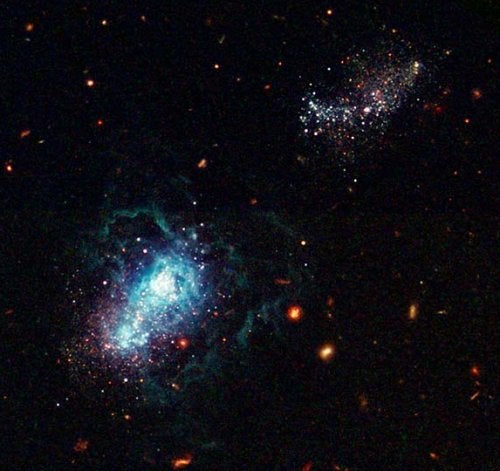Using the Hubble Space Telescope’s Advanced Camera for Surveys (ACS), an international team of astronomers believes it has identified a “boy among men.” Surrounded by older galaxies, I Zwicky 18 is a dwarf galaxy that could be only 500 million years old, making it the youngest known galaxy.
Located 45 million light-years away, I Zwicky 18 is significantly closer to our galaxy than other young galaxies. In comparison, the Milky Way Galaxy is 12 billion years old, the typical age of galaxies across the universe.
“This is extraordinary because one would expect young galaxies to be forming only around the first billion years or so after the Big Bang, not some 13 billion years later,” explains Trinh Thuan of the University of Virginia, who coauthored the study featured in The Astrophysical Journal with Yuri Izotov from the Kiev Observatory. “And young galaxies were expected to be very distant, at the edge of the observable universe, but not in the local universe.”
The team believes the galaxy is young because a survey of Hubble data didn’t reveal any stars older than 500 million years. Also, the study showed the galaxy lacks elements heavier than helium — indicating no successive generations of stars have existed and, subsequently, manufactured heavier elements through nuclear fusion.
Another team of astronomers contends the galaxy is slightly older. Goran Ostlin of the Stockholm Observatory and Mustapha Mouhcine of the University of Nottingham used Hubble’s Near Infrared Camera and Multi-Object Spectrometer (NICMOS) to find a population of cool, red stars slightly older than the stars imaged by the team led by Thaun and Izotov. Ostlin and Mouchine estimate the age at 1 billion years — still relatively young. Their study will be published in the journal Astronomy & Astrophysics.
However, the dispute over I Zwicky 18’s age resolved, a deeper mystery remains: Why is this galaxy such a late bloomer in star formation? Thaun and Izotov describe this galaxy as resting in an “embryonic state as a cold, gas cloud of primeval hydrogen and helium.” Although astronomers have no definite answer, one theory holds that an encroaching galaxy may have prompted I Zwicky 18 into making stars. Gravitational disturbances between these galaxies may have caused hydrogen clouds to collapse, and creating stars.










